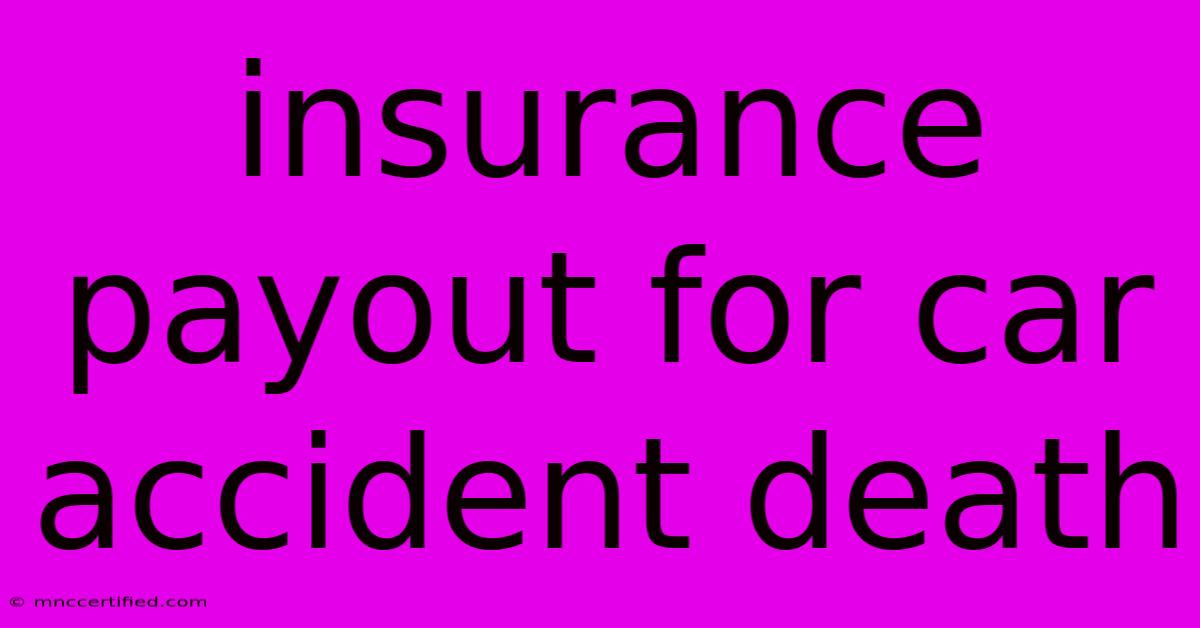Insurance Payout For Car Accident Death

Table of Contents
Navigating Insurance Payouts After a Fatal Car Accident: A Comprehensive Guide
Losing a loved one in a car accident is a devastating experience, compounded by the complex financial and legal matters that arise. Understanding insurance payouts is crucial during this difficult time. This guide aims to provide clarity on what to expect and how to navigate the process effectively.
Understanding the Different Types of Insurance Coverage
Following a fatal car accident, several types of insurance policies can potentially provide compensation. These include:
1. Life Insurance:
- Key Benefit: Provides a death benefit to beneficiaries designated by the deceased.
- Types: Term life insurance offers coverage for a specific period, while whole life insurance provides lifelong coverage with cash value accumulation.
- Claim Process: Contact the insurance company directly to file a claim, providing the death certificate and policy details.
2. Auto Insurance (Liability Coverage):
- Key Benefit: Covers damages caused by the insured driver to another vehicle or individual.
- Types: Liability coverage can be split into bodily injury liability (BIL) and property damage liability (PDL), with specific limits per accident.
- Claim Process: File a claim with the at-fault driver's insurance company, providing evidence of negligence.
3. Auto Insurance (Uninsured/Underinsured Motorist Coverage):
- Key Benefit: Protects you in case the other driver is uninsured or has insufficient liability coverage.
- Types: UM/UIM coverage can cover medical expenses, lost wages, and other damages.
- Claim Process: File a claim with your own insurance company, even if the at-fault driver is insured.
4. Wrongful Death Lawsuits:
- Key Benefit: Allows surviving family members to seek compensation for damages caused by the negligent party's actions.
- Considerations: This process is complex and may involve a lawsuit.
- Consult a Lawyer: Seeking legal advice from a qualified attorney specializing in wrongful death cases is essential.
Navigating the Claim Process: Essential Steps
1. Gather Evidence:
- Police Report: Obtain a copy from the accident scene.
- Medical Records: Collect medical bills and records of the deceased.
- Photographs: Document the accident scene and vehicle damage.
2. Contact Insurance Companies:
- Life Insurance: File a claim with the life insurance company.
- Auto Insurance: File a claim with the at-fault driver's insurance company (liability) or your own (UM/UIM).
3. Negotiate Settlements:
- Be Prepared: Understand the value of your claim based on medical bills, lost income, and other damages.
- Negotiate: Be prepared to negotiate with the insurance company.
- Consult a Lawyer: If you are unsure about the settlement terms, consider seeking legal advice.
4. Understanding Time Limits:
- Statute of Limitations: Be aware of the time limit for filing a wrongful death lawsuit in your state.
5. Emotional Support:
- Seek Counseling: Remember, grieving and processing the loss is a crucial part of healing.
Additional Considerations
- Beneficiary Designation: Ensure the life insurance policy beneficiaries are up-to-date.
- Medical Expenses: Understand the coverage limits and deductibles of the relevant insurance policies.
- Lost Income: Document lost wages due to the deceased's inability to work.
- Funeral Costs: Many insurance policies cover funeral expenses.
Navigating the aftermath of a fatal car accident is overwhelming. Understanding insurance payouts and the claim process empowers you to focus on healing and recovering. This guide serves as a starting point, but remember to consult with legal professionals and financial advisors for personalized guidance.

Thank you for visiting our website wich cover about Insurance Payout For Car Accident Death. We hope the information provided has been useful to you. Feel free to contact us if you have any questions or need further assistance. See you next time and dont miss to bookmark.
Featured Posts
-
Pearson Vue Life Insurance Exam Answers
Nov 08, 2024
-
Digital Gravity Infrastructure Partners
Nov 08, 2024
-
Bank Of England Cuts Rates To 4 75
Nov 08, 2024
-
Inside Ashley Jensens Tragic Marriage
Nov 08, 2024
-
Actors Transformation Baffles The One Show
Nov 08, 2024